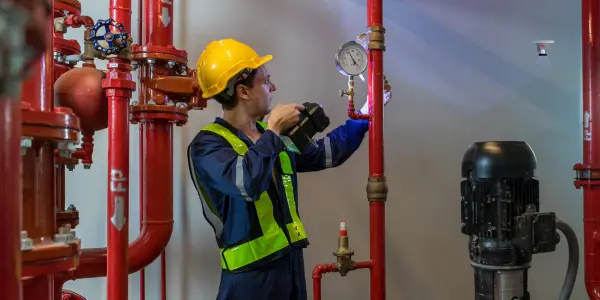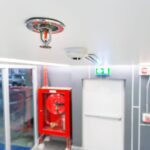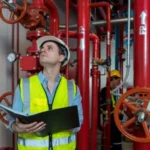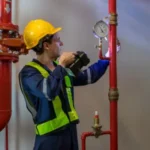Did you realize that more than 60% of business fires would have been prevented or contained if advanced fire systems were adequately maintained? Today’s technology has revolutionized the way we suppress and prevent fires, from smart detectors to completely automated suppression systems. The emergence of the fire suppression system is a new era in building safety, where precision is met with innovation.
The Evolution of Fire Safety
Fire protection has evolved a great deal from simple water sprinklers. These days, smart systems sense initial signs of a fire, warn individuals in an instant, and initiate suppression systems automatically. Such systems no longer merely extinguish a fire; they forecast and avert one.
Each element in a contemporary configuration, from fire alarm testing to routine inspections and combined response plans is coordinated like an effective safety squad. The objective? To prevent fires from ever getting started on spreading.
The Science Behind Fire Suppression Systems
A fire extinguishing system employs smart sensors to scan for smoke, heat, or temperature fluctuations. After being activated, it discharges extinguishing agents like gas, foam, or water mist, depending on the conditions.
To illustrate, in a data centre, gas systems avoid water damage, but in manufacturing facilities, foam systems are effective at chemical fires. These intelligent systems determine the precise amount of release and direction, maximum impact with minimal excess.
This smart reply is what makes next-gen systems unbeatable. They’re quick, accurate, and created to safeguard life and property with unprecedented efficiency.
The Power of Fire Alarm Testing
A top-notch system is only as reliable as its consistency. That’s why fire alarm testing is so important. Regular testing guarantees that alarms react in an instant in emergency situations.
Envision a system that senses an increase in heat but does not warn because the alarm was not tested; that delay of a few minutes can be catastrophic. Routine testing of fire alarms will prevent unnecessary alarms, verify all circuits are operational, and maintain the system within fire safety codes.
Testing is not a courtesy, it is your building’s lifeline.
Why Fire Extinguisher Inspection Matters
Even with automation, manual safety equipment still counts. Periodic fire extinguisher inspection guarantees that each extinguisher is in working condition. A single lost pin or low pressure can render it useless at the moment it’s needed most.
Through inspections, professionals examine pressure gauges, hoses, and nozzles to ensure everything functions correctly. They also check expiry dates and refill points.
Consider fire extinguishers your initial response team; little but powerful. When joined with automated systems, they form a layered defense mechanism that’s virtually unbeatable.
Blending Fire Safety Equipment with Technology
Contemporary buildings incorporate fire safety equipment that speaks with central control systems. From heat sensors to suppression nozzles, all devices are networked.
As soon as a threat is sensed, these units cooperate in real time, alarms sound, doors open, suppression engages, and emergency lights activate. This coordination wastes not a single moment in a crisis.
Modern systems also include mobile notifications, remote system monitoring, and real-time analytics. You could be home, in the office, or halfway around the globe, yet you can view your fire protection status with a simple tap.
How Fire Protection Systems Build Safer Places
A good fire protection system is not only a precautionary measure; it’s peace of mind. Such systems are designed to safeguard life, assets, and business continuity.
In the event of fire, seconds count. Fire protection systems are designed to reduce the scope for human error, react in a flash, and avoid loss. They integrate suppression, alarms, and detection units into one seamless shield.
These systems are crucial to industries such as healthcare, data storage, manufacturing, and hospitality. Not only do they satisfy safety codes, but they also instil confidence among clients and workers.
The Human Element of Fire Prevention
Technology is not sufficient. Workers need to be taught to react in a level-headed and appropriate manner in an unfortunate situation. Fire drills, emergency exits, and familiarity with operating extinguishers can make a significant difference.
The integration of technology and human consciousness produces a safety culture that minimizes panic and enhances results.
Keep in mind; machines will sense and extinguish fires, but educated humans can keep them from happening.
A Brief Look at the Future of Fire Suppression
New-generation systems become increasingly intelligent daily. With analytics powered by AI, they can identify patterns and forecast threats before something happens.
Cloud-based monitoring, temperature-mapping drones, and self-diagnosing sensors are the future. The outcome? Systems that never sleep, never miss a signal, and never fail to respond.
These technologies guarantee that the future fire suppression systems will not only protect; they’ll prevent.
Wrapping It Up
The untamed strength of next-generation fire suppression is its integration; the how alarms, extinguishers, sensors, and suppression units talk to each other in perfect harmony. Routine inspection of fire extinguishers, testing of fire alarms, and upkeep of fire protection equipment guarantee that the system works flawlessly each time.
A properly planned fire protection system can be the difference between minimal damage and catastrophic disaster. With the proper technology and proactive approach, fire safety is not only an obligation but a guarantee, one that preserves lives.
Frequently Asked Questions
1. How frequently should a fire suppression system be inspected?
Quarterly inspections and yearly maintenance are recommended by most experts. This helps to ensure that all elements, from detectors to valves, are in functioning condition.
2. What is part of fire alarm testing?
Fire alarm testing encompasses the examination of sensors, control panels, and alarms to ensure they trigger appropriately. It also checks system connectivity and communication with monitoring stations.
3. Why must I have fire extinguisher inspection if I have an automatic system?
Manual extinguishers provide instant response in small fires, purchasing time before automatic systems kick in. Both are vital layers of protection.
4. What are the top fire safety equipment items?
The top items are smoke detectors, alarms, extinguishers, hose reels, emergency lights, and suppression systems; all designed to work together for the highest level of safety.
5. Can next-generation fire protection systems eliminate fires entirely?
They can’t eliminate all sparks, but they can detect, isolate, and control them before they get out of hand, cutting damage and saving lives substantially.







